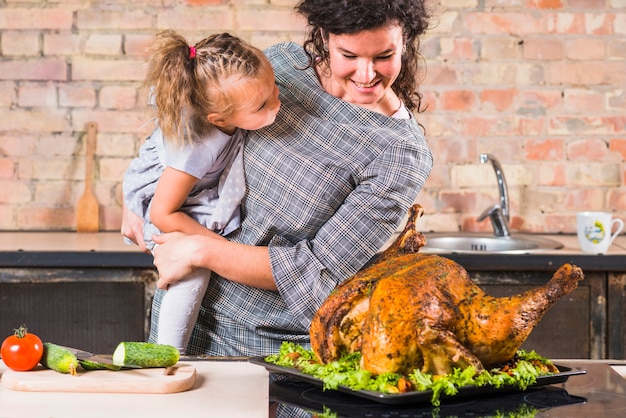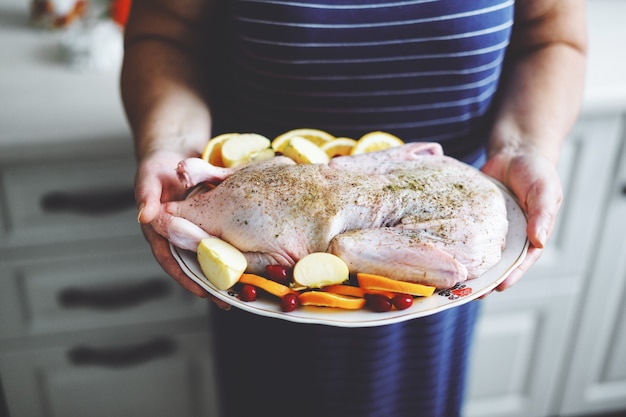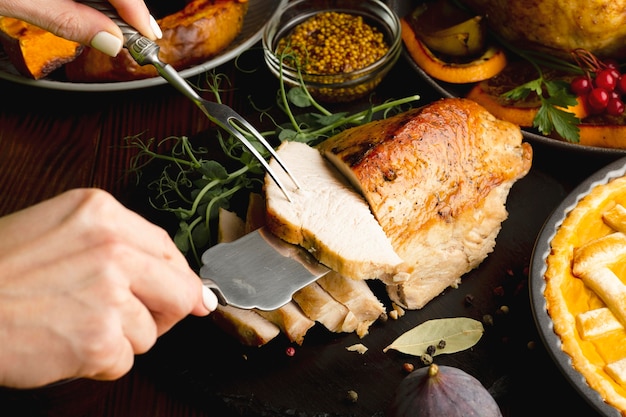Alright, let's talk turkey, folks. Not the bird itself, but the art of roasting it to juicy, golden-brown perfection. You see, I've been there, staring at a turkey in the oven, the clock ticking, and that nagging feeling that it might be a tad undercooked. Let's just say, it's not a good feeling. But don't worry, because after years of trial and error (and a few culinary mishaps, let's be honest), I've cracked the code to a truly magnificent roast turkey.
This is your ultimate guide, packed with tips, tricks, and personal anecdotes, because hey, cooking is as much about the journey as it is about the destination. So, grab a cuppa, get comfy, and let's dive in!
(Part 1) Getting to Know Your Turkey

Before we start talking about oven temperatures and cooking times, let's get a little acquainted with our feathered friend. First and foremost, the size of your turkey is going to have a massive impact on how long it takes to cook.
Choosing the Right Turkey: Size Matters
You don't have to be a turkey-weighing expert, but a rough estimate is definitely helpful. Remember, smaller turkeys cook faster than their larger counterparts. For a typical family gathering, a turkey weighing between 4kg and 6kg is a good starting point.
Turkey Anatomy 101: Understanding the Difference
To understand how your turkey cooks evenly, we need to consider its structure. The breast meat, being much leaner than the legs and thighs, cooks faster. This difference in cooking time is crucial to keep in mind when we're planning our roasting strategy.
(Part 2) Prepping for Perfection: The Essentials

Now that we've got the basics down, let's get our hands dirty, shall we? Prepping your turkey is crucial to ensure a juicy, evenly cooked bird.
Brining: A Game-Changer for Moisture
Let's face it, no one wants a dry turkey, right? That's where brining comes in. It's like giving your turkey a spa treatment, soaking it in a salty, flavorful solution to lock in moisture and enhance its taste.
I've tried countless brining recipes over the years, and my personal favorite is a simple mix of salt, sugar, and herbs. You can even add a splash of citrus juice, like orange or lemon, for an extra zing.
Stuffing: The Great Debate
Ah, stuffing – a topic that sparks heated discussions in every kitchen. Some people swear by it, others prefer to keep it separate. Personally, I'm a stuffing fan, but I always cook it separately to prevent overcooking the turkey.
If you're opting for stuffing, use good quality sausage meat and be generous with your herbs. And remember, don't overstuff the bird – it needs some breathing room!
(Part 3) The Oven: Your Turkey's Roasting Palace

Now, let's talk about oven temperatures. This is where we truly start to fine-tune our roasting process.
Choosing the Right Oven Temperature: Finding the Perfect Balance
For a perfect roast, you need a combination of high heat to achieve that glorious crispy skin and lower heat to ensure the meat is cooked through.
My go-to approach is to start the turkey off at a high temperature of 200°C (400°F) for about 30 minutes, then reduce it to 180°C (350°F) for the rest of the cooking time. This helps ensure that the turkey is beautifully browned on the outside while cooking evenly on the inside.
Oven Placement: Ensuring Even Heat Distribution
Once your turkey is nestled in the oven, make sure it's positioned on a rack. This allows the hot air to circulate freely all around the bird, ensuring even cooking. And remember, avoid overcrowding the oven with other dishes – your turkey needs space to shine!
(Part 4) Cooking Times: A Detailed Breakdown
Now, let's get down to the nitty-gritty – the actual cooking times.
Turkey Oven Cooking Times Table: A Quick Reference
| turkey weight (kg) | Cooking Time (hours) |
|---|---|
| 4 - 5 | 3 - 3.5 |
| 5 - 6 | 3.5 - 4 |
| 6 - 7 | 4 - 4.5 |
| 7 - 8 | 4.5 - 5 |
These are just general guidelines. Every oven is a little different, and your turkey might need a touch more or less time to cook.
The Importance of Temperature Checking: Don't Guess, Measure!
This is where a trusty meat thermometer comes in handy. To ensure your turkey is cooked through, check the temperature in the thickest part of the thigh, avoiding any bone.
A turkey is considered fully cooked when the internal temperature reaches 82°C (180°F). You can also check the breast temperature, which should be around 74°C (165°F).
(Part 5) Resting: Let the Turkey Relax and Recover
Your turkey is cooked, but it's not quite ready to be carved yet.
The Importance of Resting: Enhancing Flavor and Tenderness
Allow the turkey to rest for at least 30 minutes, ideally covered with foil. This allows the juices to redistribute throughout the meat, resulting in a more tender and flavorful bird.
Carving Time: A Moment of Culinary Triumph
While the turkey rests, you can whip up your sides and sauces. Once the resting time is up, you're ready to carve. I find it easiest to start by removing the legs and thighs, followed by the breast.
Leftovers: A Feast for Another Day
And let's be honest – turkey leftovers are a culinary treasure. They're perfect for sandwiches, salads, or even a delicious turkey curry. Just make sure to store them properly in the fridge, and they'll be good for up to four days.
(Part 6) Sides: Complementing Your Roast Turkey
Of course, no turkey dinner is complete without a feast of delicious sides.
Classic Sides: A Touch of Tradition
From roasted vegetables to creamy mashed potatoes, the possibilities are endless. I always enjoy a good roast potato, crisp on the outside and fluffy on the inside.
Modern Twists: Adding a Touch of Flair
For a more modern touch, try a roasted butternut squash salad or a green bean casserole with crispy onions.
(Part 7) Gravy: The Finishing Touch
No turkey dinner is truly complete without a generous pour of rich, flavorful gravy. And it's surprisingly easy to make.
homemade gravy: A Flavor Explosion
The key to delicious gravy is using the turkey drippings. Simply add some flour to the pan and whisk it over a low heat until golden brown. Then, add the drippings and some stock – and you're on your way to gravy heaven!
Tips for Making the Best Gravy: Elevate Your Gravy Game
For an extra flavor boost, add a splash of red wine or a tablespoon of Dijon mustard. And don't be afraid to season generously with salt and pepper.
(Part 8) FAQs: Your Turkey Queries Answered
So, you've got your turkey, your sides are prepped, and your gravy is bubbling away. But you might still have a few questions.
1. Can I Cook a frozen turkey?
Yes, you can, but it's best to thaw it in the fridge first. Just make sure to allow enough time – a 5kg turkey could take up to 2 days to thaw.
2. How Do I Know If My Turkey is Cooked?
Use a meat thermometer to check the internal temperature of the thickest part of the thigh. It should reach 82°C (180°F).
3. What Happens If My Turkey is Overcooked?
Overcooked turkey will be dry and tough. The best way to avoid this is to check the temperature regularly and remove the bird from the oven once it's reached the desired temperature.
4. How Do I Store Leftover Turkey?
Store leftover turkey in an airtight container in the fridge for up to four days. You can also freeze leftover turkey for up to two months.
5. What are Some Good turkey recipes?
There are endless possibilities! You can try a classic roast turkey with stuffing and gravy, or get creative with a turkey curry or a turkey and cranberry salad.
(Part 9) A Final Word: Enjoy Your Feast!
There you have it – your complete guide to roasting a turkey to perfection. Remember, confidence and a relaxed approach are key. Don't be afraid to experiment and find what works best for you. And most importantly, enjoy the process and the delicious meal you've created. After all, cooking is all about sharing good food and good company. So, gather your loved ones, raise a glass, and enjoy the feast!
Everyone is watching

Prime Rib Roast Cooking Time Chart: Per Pound Guide
Cooking TipsPrime rib roast. Just the name conjures images of lavish dinners, crackling fires, and hearty laughter. It’s ...

How Long to Bake Potatoes in the Oven (Perfect Every Time)
Cooking TipsBaked potatoes are a staple in my kitchen. They're incredibly versatile, delicious, and surprisingly easy to m...

Perfect Rice Every Time: The Ultimate Guide to Cooking Rice
Cooking TipsAs a self-proclaimed foodie, I've always been a bit obsessed with rice. It's the foundation of countless cuisi...

The Ultimate Guide to Cooking Asparagus: Tips, Techniques, and Recipes
Cooking TipsAsparagus. The mere mention of this spring delicacy conjures up images of vibrant green spears, crisp and burs...

Ultimate Guide to Cooking the Perfect Thanksgiving Turkey
Cooking TipsThanksgiving. Just the word conjures up images of overflowing tables laden with delicious food, the scent of r...
